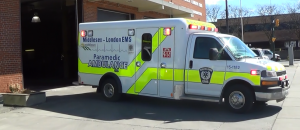As the days go by, the baby boomers are getting older and that means more people will need assistance as living on their own could be a bit more difficult. If more people are unable to live less independent this could trigger a rise in health care costs.
Now, Middlesex-London EMS is looking at referral programs. These programs will be able to refer patients to a program they may need instead of always going to the emergency room and being transported by EMS.
Quick Facts:
- Health Care in Ontario consumes 42 cents of every dollar spent on provincial programs.
- It’s predicted in the next 12 years the Health Care would be 70% of the provincial budget.
- Predicted with the 2030 population, health care costs could increase by $24-billion.
Middlesex-London EMS Deputy Superintendent and Project Lead of Community Paramedicine, Dustin Carter, says paramedics are sometimes the only ones to see the patients who they maybe treating.
“Ontario is supporting and developing the expansion of Community Paramedicine programs to improve access of additional resources to seniors or patients who have chronic issues. Paramedics are often the first and in some cases, the only points of contact between the health care system and patients who may be more house bound and patients who have psychological problems.”
Carter says this will help get the patients the care they need faster.
“This will coordinate care for patients living with complex and underlining issues. This will make sure every patient will see the right care at the right time and the right place. We’re hoping this will reduce the number of non-transport patient calls, non-essential emergency department visits and hopefully reducing overall health care spending.”
Today, Middlesex-London EMS is rolling out three programs in their spring training.
The first program allows paramedics to assess elders who maybe losing the ability to live independently. Dr. Jacque Lee helped developed the programs with three main questions to ask the patients.
“With those questions, the statistical backing showed that if a patient answered three out of three, they had a 93% chance of having an adverse outcome in less than 30 days. If they answered two out of the three, they had a 54% chance of having an adverse outcome in less than 30 days. Utilizing this as our foundation, our screening tools for referral, we’re able to better predict so that we can advocate and obtain consent and give referral to the Community Care Access Centre to help get them into the health care system,” says Carter.
The second program allows paramedics to better follow up with patients who were not transported to hospital by their own choice.
“They would sign a refusal of service form and they would release us from the scene. This program now provides us with quality insurance for all patients who refuse treatment or transport against the paramedic’s advice. So now, paramedics have the opportunity to make an informed decision based on the mechanism of the injury and potential for underlining illnesses, injury or adverse outcome. This now provides the patient an electronic form to allow for an at home or phone call follow up.”
Some organizations that will be key in the referral program:
Mental illnesses accredits for 54% of recurring 911 calls to EMS. Carter says the third program allows paramedics to use more resources to better help patients with a mental illness.
“This provides quality insurance to patients who suffer from a mental health issue and refuse treatment or transport against a paramedic’s advice. Now paramedics are able make an informed decision on the inclusion and exclusion criteria. They can activate the Crisis Mobile team from CMHA to respond to the scene to conduct a crisis intervention. This will allow mental health patients who meet the criteria of the crisis mobile to receive care from their home.”
Back in November, Ontario gave funding for the Community Paramedicine Program.
Carter says will allow organizations to collaborate and collectivity work together to give patients the right kind of care they need quicker. He says this could overall reduce the cost of health care. Some pilots have begun in February. The program will be used in full force as spring training is completed.





